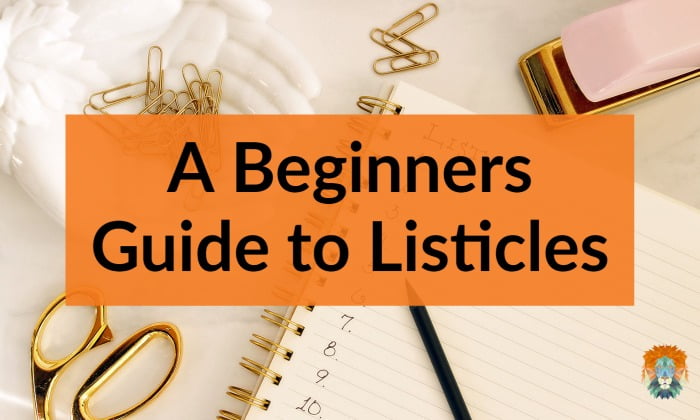When it comes to blog posts, you’d be forgiven for thinking there’s only really one format for them. Most blog posts are written a lot like the one you’re reading now – information split into sections to tell and story. But in reality, there are lots of ways you can format a blog post, and one of the most popular is a listicle. You’ve probably read a lot of listicles in your life, even if you don’t really realise it. They tend to be posts with numbers in the title, like ‘7 reasons blogging is the best’ or ‘9 ways to spring clean your home’. And while certain sites have given listicles a bad name by using them as ‘clickbait’ – a good listicle couldn’t be further from it. So what is a listicle, and how could you use one in your business?
What is a Listicle Anyway?
A listicle is quite literally a combination of an article and a list. So the content of your blog post is broken down into bullet points and written in a list-like format. They tend to be centred around a theme, like ’10 tips for healthier feet’, and each tip will form a section with a little bit of extra detail. The actual format is a bit more flexible, with some companies deciding to put each item into a section with a separate header, a numbered list, or a set of bullet points. You can split the sections with images, gifs or infographics, and make each list as long or short as you want. It really is up to you how you put it together!
Listicles are great because they avoid big, long blocks of text (which some people can find difficult to read), as well as making some more difficult topics easy to understand. They are a great way to hook readers in and keep them engaged in your blog posts, and a fantastic way to package your content for the internet. And readers love them! A listicle is perfect for someone who’s in a hurry and wants to get to the right information fast in an easily digestible manner, they are easy to create previews of for marketing purposes, and they are one of the easiest forms of content to write from a business perspective. It’s no wonder they’re one of the more popular blog post formats our there at the moment!
So how do you write a listicle?
The big question now is, how do you write your own listicle? There are a few things you need to know, and we’re going to share them with you in the form of a mini-listicle!
Choose Your Format
The first thing you need to do when writing a listicle is choosing a format to use. As we mentioned earlier listicles can come in a lot of different varieties, so you need to choose one that suits your purposes. You could choose a simple list, which is a short and sweet list of headings with a small amount of explainer text for each. Or if you need more detail, you could use an expanded list, which is the same idea as a simple list, but with more information for each point. You could create a ‘best of’ list to collate information, or you could opt for the old-fashioned bullet points.
Choose Your Topic
Your topic is almost as important as the format. Not just because you need to choose the right topic for your audience, but because the listicle format really does work better for certain topics and subjects. Topics like tips and tricks for doing X, a guide to doing Y, roundups, or creating a list based on your own knowledge and expertise are ideal, but you may find you can use listicles in more ways once you start making a list. And if you’re blogging for SEO purposes, then creating listicles around your chosen keywords can be an easy win.
Choose Your Length
The length of your listicle can be as long as a piece of string – so as long as you want it! However, a good rule of thumb is to have a look at Google and see what kind of list lengths are coming up for your chosen topics. For example, lists for date night ideas go into the hundreds, while lists about marketing your businesses rarely go above 20 -so neither should yours. It’s not a hard and fast rule, but it can help you decide how long or short your list should be.
Outline Your Content Points
Now it’s time to work out what your main points are! Brainstorm around your topic and note down any points you think are relevant. Once you have a list, see if they make sense in a particular order, or if certain points would be better presented after others. This is also a good time to merge any similar points together, and get rid of anything redundant. If you have any points that seem too detailed for one section, consider splitting them into multiple points instead. If you’re struggling for ideas, a great place to start is the ‘people also ask’ box on Google – it gives you the most commonly asked questions related to your search and means you can make sure you’re covering the topic thoroughly.
Number Your Items
There are no hard and fast rules about the way you present a listicle, but numbers or bullet points are generally preferred. They make the information much easier to scan and read, help keep a sense of separation between the points and creates a sense of progress – so a better experience overall. If your listicle is on the long side, then it helps your reader keep track of their progress as well.
Don’t Forget the Images!
Even broken up into sections, a listicle can feel like a bit of a long read. So one of the best ways to capture readers’ attention and make sure they stick with the article to the end is to include some images. Listicles with relevant images included throughout get around 94% more views than articles that don’t, so it’s worth including something! Decorative images are great, but if you’re giving instructions (as in a step-by-step guide), then visual instructions are an absolute must. People follow instructions 323% better when they have visuals as well as words, so it’s worth including some if you can.
Consider Your Title
The final part is to decide on a headline. This is where listicles have got a bad reputation in the past, because certain sites have used them liberally in ‘clickbait’ style articles. So you want to make sure your title is clear, intriguing, and encourages readers to click – without promising what you can’t deliver. It’s a tricky balance, but if you can confidently say that the claims in your title are realistic and true, you know you’ve avoided the clickbait trap.
Content marketing is constantly evolving, with new strategies and content types cropping up every day. But rather than panicking about keeping up with the trends, we always recommend you hone your brand roar into consistent, high-quality content. After all, that’s what Google loves best! At Lion Spirit Media, we are always keeping an eye on the latest content marketing trends, and combining that with our tried and tested marketing techniques to deliver exceptional results that will get your brand roar heard for miles around. If you would like to know more, just get in touch with the team today to book your free consultation.





0 Comments